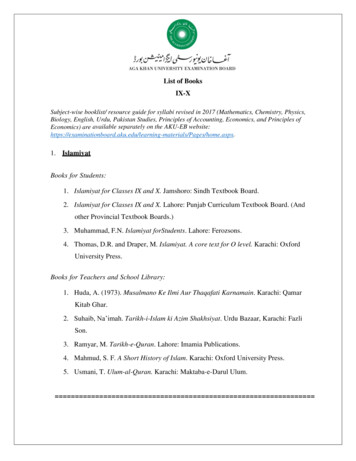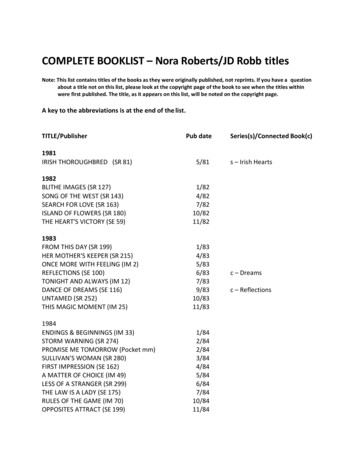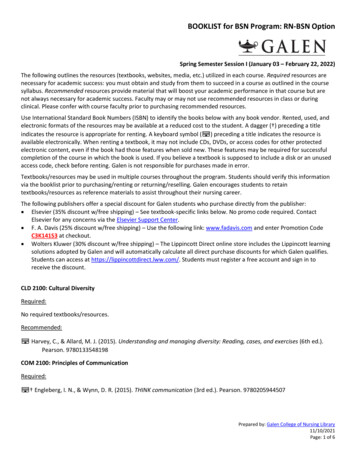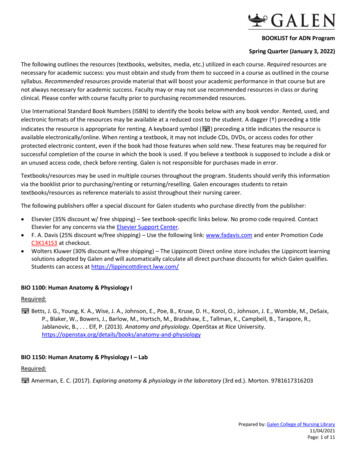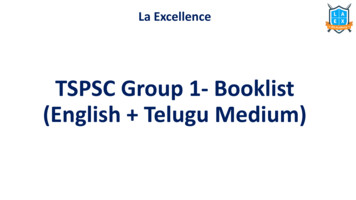
Transcription
La ExcellenceTSPSC Group 1- Booklist(English Telugu Medium)
GROUP-I SERVICESGENERAL STUDIES AND MENTAL ABILITY(PRELIMINARY TEST)1. Current Affairs – Regional, National & International.2. International Relations and Events.3. General Science; India’s Achievements in Science and Technology.4. Environmental Issues: Disaster Management- Prevention and MitigationStrategies.5. Economic and Social Development of India.6. World Geography, Indian Geography and Geography of Telangana state.7. History and Cultural Heritage of India.8. Indian Constitution and Polity.9. Governance and Public Policy in India.10. Policies of Telangana State.11. Society, Culture, Heritage, Arts and Literature of Telangana.12. Social Exclusion: Rights issues such as Gender, Caste, Tribe, Disability etc.and inclusive policies.13. Logical Reasoning: Analytical Ability and Data Interpretation
Written Examination (Main)1. English Qualifying Paper2. Essay3. History, Culture and Geography4. Indian Society, Constitution and Governance5. Economy and Development6. Science and Technology, Data Interpretation7. Telangana Movement and State Formation
SyllabusBooklistEnglish MediumTelugu MediumIndian History andCultureNCERT Class XIModern India- NCERT or SpectrumSeenaih Sir Notes for Group 1Art and Culture by Nitin SinghaniaTelugu Academy Book onIndian History and CultureOrNCERT History Books in TeluguTelangana Historyand CultureTelangana History and Culture byTelugu AcademyTelangana History and Cultureby Telugu AcademyIndian geographyNCERT Class IX- XIIIndian Geography by Majid HussianBA 3rd year, Indian Geographyby Telugu AcademyTelangana Geography Telangana Regional Geography byGenius Publications (Prelims)Telangana Regional GeographyTelugu Academy (Mains)Telangana Regional GeographyTelugu Academy (Mains)Telangana Regional Geographyby Genius Publications (Prelims)
SyllabusBooklistEnglish MediumTelugu MediumIndian and TelanganaSocietyTelugu Academy : SocialStructure ,Issues and PoliciesTelugu Academy : SocialStructure ,Issues and PoliciesIndian Constitution andPolityIndian Polity by M. LakshmikantIndian Polity by M. LakshmikantGovernanceIndian Governance by M.LakshmikantIndian Governance by M.LakshmikantEthicsEthics by G. Subba RaoEthics, Integrity, Aptitude byBalalatha
SyllabusBooklistEnglish MediumIndian EconomyIndian Economy by SriramSrirangam/Sriram IASTelugu MediumIndian Economy forCompetitive Exams - TeluguAcademyTelangana EconomyTelangana Regional Economy for Telangana Regional EconomyCompetitive Exams- Telugufor Competitive Exams- TeluguAcademyAcademyEnvironment andDevelopmentEnvironment by Shakar IASNCERT- GeographyDevelopment andEnvironment- Telugu AcademyValue AdditionBudget- India and TelanganaEconomic Survey- India andTelanganaBudget- India and TelanganaEconomic Survey- India andTelangana
SyllabusBooklistEnglish MediumTelugu MediumScience and technologyScience and technology- TeluguAcademyScience and Technology by HariKrishnaScience and technology- TeluguAcademyScience and Technology by HariKrishnaDI and Analytical AbilityAnalytical&Reasoning by ArihantTelangana StateFormationTelangana State Formation byTelugu AcademyOrTelangana movement stateformation: by S. RAJUAP Bharadwaj’s CompulsoryEnglish for Mains ExamEnglishLogical Mental Ability and Reasoningby Vijetha CompetitionsTelangana State Formation byTelugu AcademyAP Bharadwaj’s CompulsoryEnglish for Mains Exam
General English (Qualifying Test)(X CLASS STANDARD, QUALIFYING FOR INTERVIEW)(3hrs, 150 Marks)1. Spotting Errors – Spelling; Punctuation2. Fill in the blanks – Prepositions; Conjunctions; Verb tenses3. Re-writing sentences – Active and Passive voice; Direct &Reported Speech; Usage of Vocabulary4. Jumbled sentences5. Comprehension6. Précis Writing7. Expansion8. Letter Writing
PAPER-I: GENERAL ESSAY(3hrs, 150 Marks)(Candidate should write three Essays, selecting one from each Section compulsorily.Each Section contains three Questions. Each Essay carries 50 marks.)Section-I1. Contemporary Social Issues and Social Problems.2. Issues of Economic Growth and Justice.Section-II1. Dynamics of Indian Politics.2. Historical and Cultural Heritage of India.Section-III1. Developments in Science and Technology.2. Education and Human Resource Development
Paper-II – History, Culture and Geography(3hrs, 150 Marks)1. History and Culture of India, with special reference to Modern Period(1757 to 1947 A.D)2. History and Cultural Heritage of Telangana3. Geography of India and Telangana
History and Culture of India, with special referenceto Modern Period (1757 to 1947 A.D)
UNIT – I:1. Early Indian Civilizations-Indus and Vedic – Old NCERT – Class XI Ancient India Books (by R.SSharma) page no- 33 to 51, Seenaiah sir history notes (Group I note, available in the market),Indian Art and Culture by Nitin Singhania2. The emergence of Religious Movements in the sixth century BC - Jainism and Buddhism; OldNCERT by R.S Sharma, page no – 60 to 69, Seenaiah sir history notes, Indian Art and Culture byNitin Singhania3. Indo- Greek Art and Architecture – Gandhara, Mathura, and Amaravati Schools - Seenaiah sirhistory notes, Indian Art and Culture by Nitin Singhania and Old NCERT – Class XI Ancient IndiaBooks (by R.S Sharma), page no – 102, 1644. Social and Cultural condition under the Mauryan, Satavahanas, and Guptas. Old NCERT – ClassXI Ancient India Books (by R.S Sharma), page no – 86 to 140, Seenaiah sir history notes, andIndian Art and Culture by Nitin Singhania.
UNIT -II:1. The advent of Islam and its impact on Indian Society – Seenaiah sir history notes2. Nature and significance of Bhakti and Sufi Movements – Old NCERT – XI Medieval history,chapter – 11, Seenaiah sir history notes, and Indian Art and Culture by Nitin Singhania.3. Contribution of Kakatiya and Vijayanagara rulers to Language, Literature, Art, and Architecture- Old NCERT – XI Medieval history, chapter – 9, Seenaiah sir history notes, for Kakatiya refer P.R.Rao book.4. the contribution of Delhi Sultans and Mughals to Language, Literature, Art, Architecture andFine Arts, Monuments - Old NCERT – XI Medieval history, chapter – 6, 7, 8, 13, 16, 17, and 18.Seenaiah sir history notes and Indian Art and Culture by Nitin Singhania.5. The emergence of Composite Culture in the Deccan and India - Old NCERT – XI Medievalhistory, chapter – 14 and Seenaiah sir history notes
UNIT - III1. The Establishment of British Colonial Rule in India: Carnatic Wars, Battle of Plassey,Anglo- Mysore, Anglo-Maratha and Anglo-Sikh Wars - Old NCERT – class XII modernhistory, chapter – 2, Seenaiah sir history notes, and A Brief History of Modern India –Spectrum, chapter – 4 and 5.2. Economic Impact of British Colonial Rule: Land Revenue Settlements in British India; Commercialization of agriculture; Rise of Landless Agrarian Labour; Famines and Poverty;De-industrialization; Decline of Traditional Crafts; Drain of Wealth; Growth of Trade andCommerce- Economic Transformation of India; Railroads, Transport and CommunicationNetwork- Telegraph and Postal Services – Old NCERT – class XII modern history, chapter –3 &8, Seenaiah sir history notes, and A Brief History of Modern India – Spectrum, chapter– 28.
UNIT -IV: Anti – British uprisings: Tribal and Peasant revolts in the Nineteenth Century-Causes andConsequences of 1857 revolt - A Brief History of Modern India – Spectrum, chapters – 6 and 7and Seenaiah sir history notes. Factors responsible for the rise of Indian Nationalism - Seenaiah sir history notes, A BriefHistory of Modern India – Spectrum, chapters – 10. Rise and Growth of Socio-Religious and Anti-Caste Movements: Brahma Samaj, Arya Samaj,Aligarh Movement, Satya Shodak Samaj, Jotiba and Savithribhai Phule, Pandita Ramabai,Narayana Guru, Ayyankali, Annie Beasant; Non- Brahmin, Justice, and Self-Respect Movements:Periyar, Mahatma Gandhi, Ambedkar, and others - Old NCERT – class XII, Modern India, chapter– 5, A Brief History of Modern India – Spectrum, chapters – 8 and 9 and India’s Struggle forIndependence by Bipin Chandra and others.
UNIT – V: Three Phases of Indian Freedom Struggle (1885-1947) – Old NCERT – class XII, Modern India, chapters –9, 11, 12, and 13. Seenaiah sir history notes, and India’s Struggle for Independence by Bipin Chandra andothers. The rise and growth of All India Kisan Sabha, Workers, and Tribal movements - Seenaiah sir history notesand A Brief History of Modern India – Spectrum, chapter – 31, 32 1/Unit-1.pdf), A Brief History of Modern India –Spectrum, chapters -8. Growth of Socialist and Communist Movements; Growth of Communalism -Old NCERT – class XII,Modern India, chapters – 13. A Brief History of Modern India – Spectrum, chapters – 12 and 13 and India’sStruggle for Independence by Bipin Chandra and others. Independence and Partition of India – Seenaiah sir history notes, A Brief History of Modern India –Spectrum, chapter – 25, and India After Independence, by Bipin Chandra.
Telangana History
TOPICSUB-TOPICSatavahanasIkshvakusBOOKTelangana historyculture by TeluguAcademyTelangana historyculture by TeluguAcademyTelangana historyculture by TeluguAcademyHISTORYVishnukundinsANDCULTURE OFSocio-Cultural ConditionsANCIENTTelangana historyTELANGANA Language, Literature, Art andculture by TeluguArchitecture during aboveAcademythree dynastiesTelangana historyRise and growth of Jainism andculture by TeluguBuddhismAcademyUNITChapter 3Chapter 4Chapter 6Chapter 3,4 and 6Chapter 3 (Pg no: 49 &50) ; Chapter 4 (Pg no:68 & 69); Chapter 4(Pg no; 99 to 102)
Kakatiyas and Velama kingdomsChapter 9and their contribution to Socio- CulturalDevelopment, Literature, Music, Dance,Art andTelanganaAndhistory-culture byTelugu AcademyChapter 10ArchitectureMEDIEVALTELANGANAQutub Shahis and their contribution toTelugu literature, art and na historyculture by TeluguChapter 12AcademyProtestTelangana historyMovements against Kakatiyas and QutubShahis- Sammakka Sarakka andSarvaipapannaculture by TeluguAcademyChapter 13 (pgno: 293)
The Establishment of Asaf Jahi Telangana history-culture byDynastySalar Jung Reforms andModernization of TelanganaTelugu AcademyTelangana history-culture byTelugu AcademySocio- Economic developmentTelugu AcademyTelangana history-culture byTelugu AcademyBritish Paramountcy and NizamandChapter 20Deshmukhs etc.VettiChapter 16Chapter 18under the Nizams – Land Tenures Telangana history-culture byand Social System, Jagirdars,Chapter 14Telangana history-culture byTelugu AcademyChapter 18, (Pg no: 380)Chapter 15
Revolt of 1857 in Hyderabad and therole of Turre Baz KhanTelangana history-cultureby Telugu AcademyChapter 17Socio- Economic Development during the rule of thesixth and seventhNizamsGrowth of Railways, Transport and CommunicationTelangana history-cultureChapter 22by Telugu AcademyChapter 12System, Establishment of Industries,Educational Institutions – Monuments of Asaf Jahiperiod.Socio-Cultural Awaking in Telangana- Andhra Sarasvath Telangana history-cultureParishat – Literary and Library Movements;by Telugu AcademyChapter 24
Andhra Mahasabha – Social ReformMovements -Brahma Samaj, Arya Samaj and Adi- Hindu andDalit Movements, Role of BhagyareddyTelangana history-Chapter 24culture by TeluguAcademyChapter 28Varma.Telangana history-Andhra Mahila Sabha and the growth of Women’s Movement culture by TeluguChapter 29AcademyRole of Hyderabad StateTelangana historyculture by TeluguCogress and Vandemataram Movement.Chapter 27AcademyPeoples Movement against the Nizam’s Rule – Adivasi revolts – Telangana historyRamji Gond and Kumaram BheemuTelangana Peasants Armed culture by TeluguStruggle – Role of Andhra Mahasabha and the CommunistsAcademyChapter 25
MajlisIttehadul- Muslimeen PartyTelangana historyculture by TeluguChapter 24 (pg no: 508)AcademyRajakars and Kasim RazviTelangana historyculture by TeluguChapter 25AcademyPolice Action and the End of Nizam’s Telangana historyRule – Integration of HyderabadState into Indian Union.culture by TeluguAcademyChapter 31
Indian Geography
SubjectTopicGeographyof IndiaPhysical settingNCERTStandard BooksIndia ComprehensiveIX-Chapter 1, XI-Chap 1 Geography by KhullarChapter1Indian Geo by MajidHussain Chapter 2Physiography,IX-Chapter 2, XI-Chap 2Drainage,IX-Chapter 3, XI-Chap 3 Chapter 3Climate- Mechanism ofMonsoon, effect of El-Nino andLa Niño,Rainfall variability- Floods andDroughtSoils, Vegetation and WildlifeDegradation and ConservationMeasures.IX-Chapter 4, XI-Chap 4 Chapter-4IX-Chapter 4, XI-Chap 4 Chapter-4IX-Chap 5, X Chap 5, XIChapter-5, 6Chap 5,6
Major Minerals and Energy Resources-distribution andconservation,X-Chapter 5,XIIchap 7Chapter-7,8Energy Crisis – role of non-conventional energy resourcesChapter-8Marine Resources –Economic significance, EEZ.Chapter-7Water resources – availability, problems of inter – stateWater sharing,Conservation Measures.Chapter-7Agriculture and IrrigationX-Chapter 4, XIIchap 5Chapter-9Major Food a nd Non-Food crops,Chapter-10Agro Climatic RegionsChapter-10Green Revolution,Chapter-9recent trends in AgricultureChapter-9Chapter-9,15Major Irrigation Projects and Command Area Development
Industries-X Chapter 6,Chapter-11XII-chap 8,Chapter-11Major Industries - Iron and Steel,Cotton Textiles, Cement, Sugar, Automobile, IT, & FoodProcessing IndustriesLocalisation FactorsIndustrial Corridors & Economic DevelopmentTransportation:X Chapter 7Means of TransportationXII-chap 10Role of Road and Rail Network in Economic DevelopmentHighways and Express HighwaysMajor Portschanging trends and direction of India’s Trade role of WTO;Strategic location of India in the Indian aComprehensiveGeography byKhullar- Chapter1
PopulationIX-Chapterchapter 16,XII- Indian Geo by MajidHussain Chapter 13distribution, growth,Chapter-13Demographic characteristics,Chapter-13Demographic dividend and transition,Chapter-13HDIXII-Chapter 3Chapter-13Population problems and Policies.Chapter-13Urbanisation processChapter-14Spatial patternChapter-14growth of MegacitiesChapter-14problems of Urban Growth and Policies, XII-chapter 2Chapter-14concept of Smart CitiesYojana, Smartcities.gov.in
Telangana Geography
Telangana RegionalGeography- TeluguAcademy (Mains)GeographyGeographical extent of HyderabadofState and present Telangana State Chapter 1TelanganaPhysical setting-ReliefChapter 1ClimateChapter 2SoilsChapter 3RiversChapter 5Forest cover and Wild life–distribution, depletion andconservationChapter 4Minerals and Energy resourcesChatper 6, 7Coal, Iron and Limestone distribution Chatper 6, 7Thermal and Hydro Power ProjectsProblems and ProspectsChatper 6, 7Telangana RegionalGeography by GeniusPublications (Prelims)Chapter 1, 2Chapter 3Chapter 6Chapter 4Chapter 7Chapter 8, 11Chapter 8, 11Chapter 8, 11Chapter 5
AgricultureRainfed/Dry land AgricultureDrought prone areas and Mitigation MeasuresSources of Irrigation: Canals, Tanks and Wells, Depletionof Ground Waterand its conservation- Mission Kakatiya.IndustriesCement, Sugar, Pharma, Electronic, Tourism, IT, ITIR, SEZs.Handicrafts and Household Industries and their problemsRoad and Rail Network distribution and role in EconomicDevelopmentPopulation distribution, growth, density, demographiccharacteristics(sex ratio, age, literacy, etc.,)Tribal Population - distribution, problems of Tribal areasand policies for Tribal Area Development.Telangana RegionalGeography- TeluguAcademy (Mains)Telangana RegionalGeography by GeniusPublications (Prelims)Chatper 8Chatper 8Chatper 8Chapter 9Chapter 9Chapter 9Chapter 9Chatper 9Chatper 11Chatper 11Chatper 11Chapter 5,9Chapter 5Chapter 10Chapter 10Chapter 10Chatper 12Chatper 13Chapter 10Chapter 16Chatper 13Chapter 16Chatper 13Chapter 16
Telangana Regional Telangana RegionalGeography- Telugu Geography by GeniusAcademy (Mains) Publications (Prelims)Urbanisation in Telangana StateSpatio-temporal changes,Urban Growth and MigrationEvolution and phases of Urban Growth of Hyderabadtransformation from historical to modern cosmopolitanMegapolisPrimacy of Hyderabad in Telangana State,City structure, Industries and Industrial estates,urban infrastructure and transport - ORR and Metro Problems and Planning,role of GHMC and HUDA (Metropolitan DevelopmentPlan – 2031, HMDA)Hyderabad as a Tourist Centre and Global city.For all the current events and statistics of TelaganaGeographyChatper 14Chatper 14Chatper 14Chatper 15NANANAChapter 15Chatper 15Chatper 15Chatper 15Chatper 15Chatper 15,16NAChapter 15Chapter 15Chapter 15Chapter 15Chatper 15Chapter 15Chatper 15Chapter 14https://www.telangana.gov.in/
Paper –III – Indian Society, Constitution and Governance(3hrs, 150 Marks)1. Indian Society, Structure, Issues and Social Movements2. Constitution of India3. Governance
Suggested Books:1)Indian Polity - M. Laxmikanth 6th Edition2)Governance in India - M. Laxmikanth3)Society- Telugu Academy4)Yojana, Kurukshetra, PIB & Ministerial Websites.5)Ethics, Integrity and Aptitude - G. Subba rao6)2nd ARC report - (La Excellence IAS Academy Public Administration Notes)
Indian and Telangana Society
TopicSources1. Indian Society: Salient features, Unity in Diversity; Family, Telugu Academy :Social Structure ,Issues andMarriage, Kinship, Caste, Tribe, Religion, Language; Rural – PoliciesUrban continuum; Multi-culturalism.Ch 1-Indian Social Structure2. Social Exclusion and Vulnerable Groups: Scheduled Castes, Telugu Academy :Social Structure ,Issues andScheduled Tribes, Backward Classes, Minorities, Women, PoliciesChildren, Aged and Disabled.Ch 1,Ch 2 & Ch 53. Social Issues: Poverty; Unemployment, Child Labour, Telugu Academy :Social Structure ,Issues andViolence against Women; Regionalism; Communalism and PoliciesSecularism; Corruption; Caste Conflicts, Problems of Ch 2-Social IssuesAgricultural Labour; Urbanization; Development andDisplacement; Environmental Degradation; SustainableDevelopment; Population Explosion; Agrarian Distress;Migration.
TopicSources4. (a)Social Issues in Telangana: Vetti; Jogini and Devadasi Telugu Academy :Social Structure ,Issues andSystem; Girl Child; Flourosis; Child Labour; Migrant Labour; PoliciesChild Marriages.Ch 4-Telangana specific Social Issues4 (b) Social Movements in TelanganaTelugu Academy :Social Structure ,Issues andPoliciesCh 3(B)-Social movements in Telangana5. Social Policies and Programmes in India and Telangana: Telugu Academy :Social Structure ,Issues andPolicies for Women, Children, Aged and Disabled; Policies for PoliciesScheduled Castes, Scheduled Tribes, Backward Classes and Ch 5: Social Policies and Welfare ProgramsMinorities; Environmental Policy; Population Policy; Policy onEducation; Policy on Health; Poverty Alleviation Programmes;Welfare Schemes for Scheduled Castes, Scheduled Tribes,Backward Classes, Women, Children, Minorities, Aged andDisabled
Indian Polity
Indian Polity-Chapter- 1: Evolution of Indian Constitution: (Indian Polity by M Laxmikanth)1. Role of the Drafting Committee( Chapter 11: Basic Structure of the constitutionIndian Polity by M Laxmikanth)2. Constitutional Philosophy (Chapter 3: The Philosophy of the Constitution - D DBasu)3. Preamble; ( Chapter 4: Preamble of the Constitution- Indian Polity byLaxmikanth)M4. Salient features & Basic Structure( Chapter 11: Basic Structure of the constitutionIndian Polity by M Laxmikanth)5. Amendments(Chapter 10: Amendment of the Constitution- Indian Polity by MLaxmikanth)
Chapter- 2: Fundamental Rights: (Chapter 7: Fundamental Rights- Indian Polity byLaxmikanth)M1. Nature and Scope (Chapter 7: Fundamental Rights- Indian Polity by M Laxmikanth)2. Expanding horizons of Fundamental Rights(Chapter 7: Fundamental Rights- Indian Polity byM Laxmikanth)3. Enforceability against State and others(Chapter 7: Fundamental Rights- Indian Polity by MLaxmikanth)4. Welfare State and Distributive Justice under the Constitution(Chapter 7: FundamentalRights- Indian Polity by M Laxmikanth)5. Directive Principles of State Policy - Rule of Law(Chapter 8: Directive Principle of StatePolicy- Indian Polity by M Laxmikanth)6. Fundamental Duties.(Chapter 9: Fundamental Duties- Indian Polity by M Laxmikanth)
Chapter- 3: System of Government: Parliamentary system(Chapter 12: Parliamentary System- Indian Polity by M Laxmikanth) Central Government: President(Chapter 17: President- Indian Polity by M Laxmikanth)Prime Minister(Chapter 19: Prime Minister- Indian Polity byM.Laxmikanth)Council of Ministers(Chapter 20: Central Council of Minister - Indian Polityby M Laxmikanth) Parliament: Powers and Functions(Chapter 22: Parliament- Indian Polity by MLaxmikanth) State Government: Governor(Chapter 30: Governor- Indian Polity by M Laxmikanth)Chief Minister(Chapter 31: Chief Minister- Indian Polity by M. Laxmikanth)Council of Ministers(Chapter 32: State Council of Ministers- IndianPolity by M Laxmikanth) Legislature: Powers and Functions, Legislative Privileges(Chapter 33: State LegislatureIndian Polity by M Laxmikanth)
Chapter- 4: Judicial System in India: Supreme Court(Chapter 26: Supreme Court - Indian Polity by M Laxmikanth) High Courts (Chapter 34: High Court- Indian Polity by M Laxmikanth) Administrative Tribunals(Chapter 35: Tribunals- Indian Polity by M Laxmikanth) Subordinate Judiciary(Chapter36: Subordinate Courts - Indian Polity byLaxmikanth) Judicial Review(Chapter 27: Judicial Review- Indian Polity by M Laxmikanth) Judicial Activism(Chapter 27: Judicial Activism- Indian Polity by M Laxmikanth) Independence of Judiciary Judicial Accountability.M
5. Federal system: Centre-State Relations- Issues and Challenges pertaining to the Federal Structure(Chapter 14: Centre - State Relations- Indian Polity by M Laxmikanth) Local Self-Government 73rd and 74th Constitutional Amendments for sharing ofpowers - Panchayat Raj and Municipal Institutions(Chapter 38: Panchayati Raj- IndianPolity by M Laxmikanth)(Chapter 39: Muncipalities - Indian Polity by M Laxmikanth) Resolution of Inter-State disputes with reference to Water Disputes- Challenges ofImplementation.(Chapter 15: Inter - State Relations - Indian Polity by M Laxmikanth)
Indian Governance
III. GovernanceChapter- 1: Governance and Good Governance, E-Governance-Applications and Models;Governance at Unionlevel- Cabinet SecretariatPrime Minister's Office (PMO),Central SecretariatMinistries and Departments(Chapter 9: Union Government and Administration in India by Laxmikanth)
Constitutional bodies Finance Commission(Chapter 45: Finance Commission - Indian Polity Laxmikanth) Election Commission(Chapter 42: Election Commission- Indian Polity Laxmikanth) Union Public Service Commission(Chapter 43: UPSC- Indian Polity Laxmikanth) Comptroller and Auditor General of India(Chapter 51: CAG - Indian Polity Laxmikanth) National Human Rights Commission(Chapter 55: NHRC- Indian Polity Laxmikanth) National Commissions for SC(Chapter 47: NCSC - Indian Polity Laxmikanth) National Commissions for ST(Chapter 48: NCST- Indian Polity Laxmikanth) National Commission for Minorities(Chapter 11: Governance in India Laxmikanth) National Commission for Women(Chapter 11: Governance in India Laxmikanth) Parliamentary Committees- Estimates CommitteePublic Accounts CommitteeCommittee on Public Undertakings.(Chapter 23: Parliamentary Committees - Indian Polity by Laxmikanth)
Chapter- 2: Governance at State and District levels-Secretariat and Directorates and theirrelationships; District Administration-Role of Collector(Chapter 11: State and District Administration byPublic Administration - Laxmikanth) Institutions of Rural and Urban Governance-Powers and Functions, Systems for delivery of Services; Cooperatives, State Finance Commission; Devolution of Powers and Finances- Issues and Challenges. Development Corporations for SCs, STs, B.Cs, Minorities and Disabled Welfare; Control over Administration-Legislative, Executive and Judicial Control
Chapter- 3: Programmes, Agencies and Institutions working for the development ofUrban and Rural Areas; People Centred Participatory Development; Poverty Alleviation Programmes; Women Empowermentand Inclusive Growth; Rights related to Health, Food Security and Education-Issues and Challenges.(Yojana, Kurukshetra & PIB)
Chapter- 4:Debates on Development and Development Processes; State and Provision of Services; State and Market; Involvement of Civil Society-Community Based Organizations (CBOs) and NGOs Self-Help Groups, (SHGs), Charities and Stakeholders(Chapter 5: Accountability and Control - Public Administration by Laxmikanth) Public-Private Partnerships (PPP); Corporate Social Responsibility(Vijay Kelkar Committee Report)
Chapter- 5: Ethics and Values of Administration; Neutrality of Civil Services, Committed Bureaucracy, Politician and Civil Servant Relations(Chapter 10: Individual ethics of Civil Servants- Ethics, Integrity and Aptitude -G. Subba rao) Citizen Charters & Gender Sensitization(Chapter 17: Citizen Charter - Ethics, Integrity and Aptitude - G. Subba rao) Transparency and Accountabilityof Administration
Prevention of Corruption in Administration- Central Vigilance Commission Central Bureau of Investigation ACB and Consumer Protection Mechanisms(Chapter 12: Mechanisms for Fighting Corruption - Ethics, Integrity and Aptitude G. Subba rao) Lokpal & Lokayuktha (Chapter 15: Lokapal - Ethics, Integrity and Aptitude G. Subba rao Application and Impact of Right to Information Act-2005(Chapter 16: RTI Act,2005 Ethics, Integrity and Aptitude - G. Subba rao) Administrative Reforms(2nd Administrative Reforms commission recommendationsLa Excellence Public Administration Material)
Paper –IV – Economy and Development(3hrs, 150 Marks)1. Indian Economy and Development2. Telangana Economy3. Development and Environmental Problems
Indian Economy
TOPICNational Income -Concepts andMeasurement of National Income Nominal and Real IncomeStructure and growth of Indianeconomy – Sectoral trends inNational Income of IndiaBOOKCHAPTERIndian Economy by SriramSrirangam/Sriram IASChapter 1Indian Economy by SriramSrirangam/Sriram IASEconomic Survey 2021-22Poverty and Unemployment:Concepts of Poverty - Income-basedPoverty , non-income Povertycapability approach (Human PovertyIndex)Indian Economy by SriramSrirangam/Sriram IASChapter 48 & 49Chapter 1Chapter 27
TOPICMeasurement of Poverty and trends in Poverty;Concepts, estimates and trends of UnemploymentCHAPTERBOOKIndian Economy by SriramChapter 27 & 36Srirangam/Sriram IASIndian Economy by RameshSinghChapter 20Indian Economy by SriramMoney and Banking: Money supply, Structure ofSrirangam/Sriram IAS24Indian Banking and non-banking financialinstitutions; Reforms in Banking sector; RegulationChapter 13,14, 15, 23 andEconomic Survey 2021-22Chapter 1of credit by RBIIndian Economy by RameshSinghChapter 12
TOPICBOOKPublic Finance: Tax structure, Central and state1. Indian Economy bytaxes; Government expenditure in revenue andSriram Srirangam/Sriramcapital account; Public debt: composition-IASinternal and external debt; Monetary Policy,2. Economic Survey 2021-Fiscal Policy22CHAPTERChapter 11 & 12Chapter 2Budget SpeechUnion Budget: Budget AnalysisMarch 2022 Yojana kurukshetraPlanning in Indian economy: Objectives,Indian Economy by SriramPriorities, Strategies, Achievements of Five YearSrirangam/Sriram IASChapter 4Plans; 12th FYP - Inclusive growth ; NITI Aayog;Liberalization, Privatisation, Globalisation:Features and Implications.Indian Economy by RameshSinghChapter 4,5 and 6
Telangana Economy
TopicTelangana EconomyEvolutionSyllabusBookTelangana economy in Hyderabad StateTelugu Academy(Agriculture, Industry and Trade)(Chapter 1)Telangana economy in United AP (1956-2014)-Telugu Academy (Deprivation and Under developmentChapter 2)Structure and Growth of Telangana economy: Sectoraltrends in GSDPTelugu Academy (Ch. - 3)Per capita income - Income inequalities and PovertyDemographic Structure and TransitionHuman resourcesDemographic dividendTelugu Academy (Ch. 12)sex ratio, fertility rate, mortality ratesLiteracy and Occupation structure
TopicSyllabusBookFirst generation (1947-1970) and II generation land reforms (1970onwards)Abolition of Intermediaries : Zamindari, Jagirdari and InamdariLand reformsTenancy Reforms : Land ceiling ;Telugu Academy (Chapter5) Pasha sir notesLand alienation in Scheduled areasImpact of land reforms.Trends in share of crop and allied sectors in GSDPAgriculture andAllied sectorsTelugu Academy (Chapter6,7 and 8)Distribution of land holdingsTrends in Irrigation - Problems of dry land AgricultureDependence on AgricultureCropping pattern TrendsTrends in productivityAgricultural Credit, Extension and MarketingCooperatives and Producer CompaniesTelugu Academy (8.5, 8.8,8.10, 8.11)
TopicSyllabusBookIndustrial developmentStructure and growth of industrial sectorIndustry and ServiceMicro Small and Medium Enterprises (MSME) sector,sectorsRevival of sick industriesIndustrial infrastructure- PowerTelugu Academi -Industrial Policy of TelanganaChapter (Ch. 10&11)Structure and growth of service sectoremployment trends in Industry and Service sectorsInformation and Communication Technology (ICT) Policyof Telangana.
Development and Environmental Problems
Chapter-1 : Environment vs Development:Definition of Environment (Shankar IAS Chapter 1)Environmentalism (“ IGNOU” Master's in Anthropology (MAAN) 2ndYear MANE-005Environmental Anthropology , Block-5 Development policies, environmental Impactand collective action Unit-3 Environmental Movements In India . Pdf available in the linkgiven below https://egyankosh.ac.in//handle/123456789/42059 )Environmental Protectio
English Medium Telugu Medium Indian History and Culture NCERT Class XI Modern India- NCERT or Spectrum Seenaih Sir Notes for Group 1 . XI Ancient India Books (by R.S Sharma), page no -86 to 140, Seenaiah sir history notes, and Indian Art and Culture by Nitin Singhania. UNIT -II: 1.
